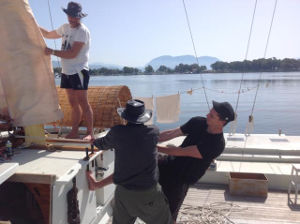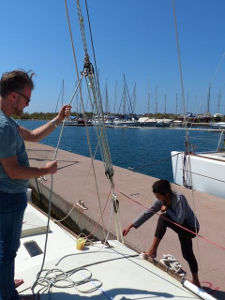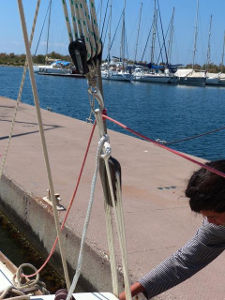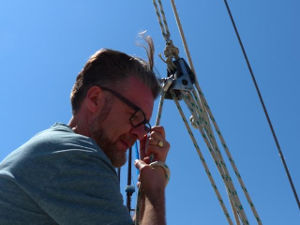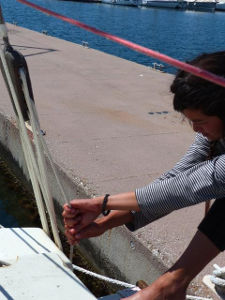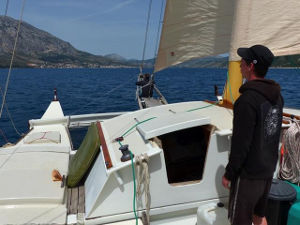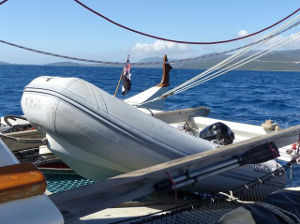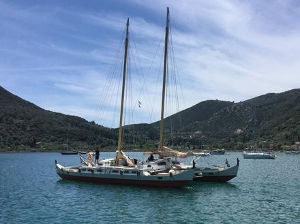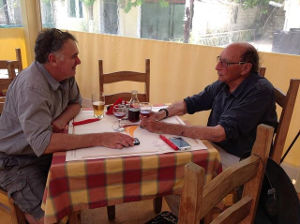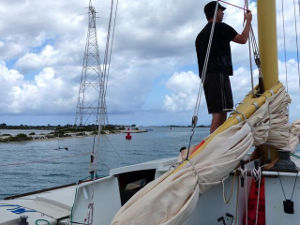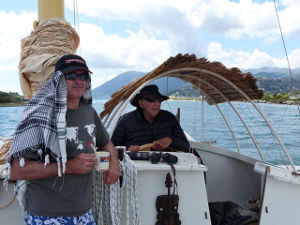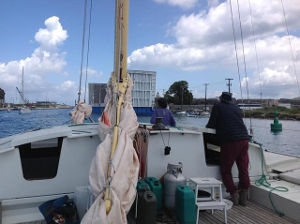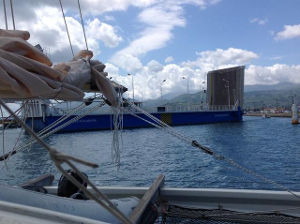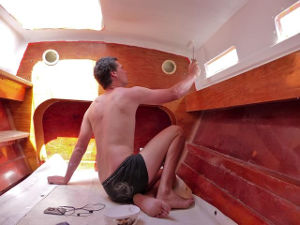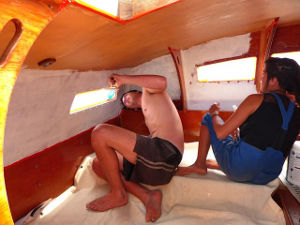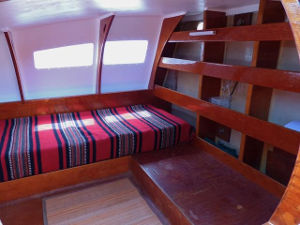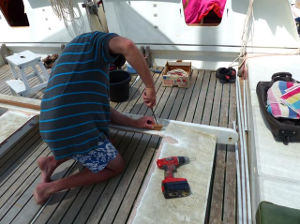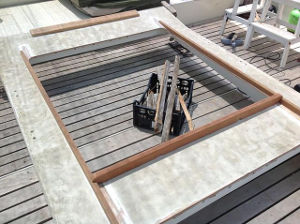Two and a half years have gone by since my last instalment. Spirit of Gaia was launched and sailing, but there was still more work to do.
Spring 2017
Gaia was left moored on the outer pontoon in Messolonghi Marina for the winter of 2016-17. On our return the next Spring we knew we could not stay in Messolonghi. The legal impasse in the marina was still the same and if a yacht now left the pontoons it would not be able to return. We needed to find a new home for Gaia, and particularly we needed somewhere to antifoul.
We decided to sail to Lefkas Island to see the situation in the traditional boat yards and also sail through the Lefkas Canal to Preveza where there are three large yards where boats are lifted out and kept on the hard. Maybe they could lift Gaia.
Tightening The Dyneema Rigging
We once again tightened the new Dyneema rigging with the help of three volunteers, two young travelling craftspeople, Lu and Adam, and Jens-Einar, a Norwegian bookshop manager and owner of a Wharram Narai in the East of Greece.
Removing Barnicles
Before we could go anywhere we had to scrape the beard of Gaia’s bottom. This is not too hard to do as the underwater hull sides of Gaia are almost flat and only go down just 1m to the 5cm wide keel. With a 30cm wide scraper on a broom handle, run from waterline to keel, one can scrape off large amounts of grows quite quickly. This could be done from the pontoon or the dinghy, so at the end there was only a small amount of swimming to clean the barnacles around the edges of the rudders and narrow keels.
Sailing To Lefkas
We said farewell to Messolonghi, still hoping we might be able to come back at some later time. Sailing round the coast was beautiful, this part of the Ionian Sea is very varied with low river plains and sudden high rocky hills or islands. There are many beautiful anchorages and inlets, some with towns at the top. We stopped in the very Greek town of Astakos on the mainland coast. On a earlier visit by car we had seen a small boatyard there, with a Pahi 31 hauled out. Sadly it was not suitable to haul out our big Gaia. We bought a new battery in the town as one of our batteries, given to us in Messolonghi Marina by another yacht owner, had died.
We sailed on to Nidri on the east side of Lefkas Island via the pretty town of Mitikas, built on a low spit of land, where Jens Einar had to leave us. Nidri is a busy yachting centre in a very sheltered natural harbour. We spent some days anchored in Tranquil Bay opposite the small tourist town of Nidri. There Brian joined us, another new volunteer we had not met before.
Brian over the following years has become a close friend. He grew up in East and South Africa, restored and then sailed a trimaran with his wife Juliet across the Pacific from California to Australia, has built and worked on many other boats. Brian is capable of doing anything, a skilled engineer and boatbuilder, he makes and flies trike Para gliders in his ‘spare time’.
New Dinghy
In Nidri we decided to get a new second-hand dinghy. Our old dinghy dated from 1999 and was leaking, water and air. Even with the repairs done by Glenn the previous year, it was past its best. We donated it to another yacht that was struggling with an even more leaky dinghy. We managed to buy a hard bottom ‘Caribe’ dinghy that had come from Florida on a monohull yacht. The owners found it too heavy to haul on board. However with our stern ramp, hauling up a heavy dinghy was not a problem and the hard bottom was much more comfortable for James to get in, and it was dry!
Vliho Bay
We moved up into sheltered Vliho bay. This is a beautiful very large anchorage completely surrounded by land. Many yachts anchor here in an average depth of 6m and there is a small Yachtclub at Vliho, with bar, restaurant, showers and washing machines. It is a friendly place where many British yachties hang out. They also offer guardianage to yachts when the owners need to go home.
We asked the yachtclub about whether we might also be able to get guardianage in the summer, but at first we were told they would not have room for such a large boat in their ‘raft’, which is where they keep all the yachts tied to moorings and shore lines.
Through the Lefkas Canal to Preveza
We decided to sail up to Preveza and check out the boatyards there, maybe they could lift us to antifoul. We had heard that two of the yards, ‘Aktio’ and ‘Ionian’ did not have a slip wide enough for us (Gaia is 8.5m wide), so we planned to visit the big ‘Cleopatra’ yard.
Our first passage through the Lefkas canal was exciting. One travels for some distance through low land between the Northern end of Lefkas and the mainland in a wide channel marked with buoys. One then comes to the town of Lefkada on the left with the big Lefkas Marina, too expensive for us. After that the canal is narrow between two causeways. It is important to time one’s passage as the bridge at the top of the canal opens precisely on the hour, every hour. If there is a strong wind in the narrow stretch before the bridge you don’t want to have to hang around there, particularly not with a big, wide catamaran with two small motors (two 9.9hp Yamaha high thrust).
So we went through the canal early, before the wind would spring up. The bridge is like a floating pontoon that swings round to open. Once through you are in open water (all the way to Italy), quite different from the sheltered water behind the Southern Ionian islands. We had sailed in this area many times when we were based in Corfu from 1999 till 2007, so knew Preveza and its entrance channel.
Preveza is famous in ancient history as the site where the battle of Actium between Octavian (Augustus) versus Mark Antony and Cleopatra took place. Mark Antony and Cleopatra lost the battle and this led a year later, after more defeats, to the suicide of both Mark Antony and Cleopatra.
Scouting For A Haul Out
We anchored close to the boatyards and Brian and I went ashore to reconnaissance. The two smaller yards were friendly, but indeed could not lift Gaia. Cleopatra yard is enormous, with posh offices and acres of boats in marked and numbered lanes. There was a huge travel lift. We waited in the swish office for someone to have time to talk to us. We picked up a brochure from the smart coffee table with a price list and were horrified. When finally able to speak to the receptionist we were told they had a waiting list of ‘big’ yachts to be lifted and only a small area where they could be placed. AND the prices for this were even higher than in the brochure.
We walked out and watched a multi million pound super yacht being manoeuvred into the lifting area. Brian and I discussed checking out the old yards in Nidri to see what they could do.
Preveza town is nice, we moored along the quayside and did some shopping and checked out the small marina by the town. A friendly old man on a moped comes to the yachts on the quay and sells his home grown honey, olive oil and eggs. The next day we decided to head back to Nidri and Vliho.
Back at Vliho Yachtclub we met the owner, Ruairi Bradley, a jovial Irishman, who it turned out knew all about ‘Wharram’ and was pleased to find us a place in his ‘raft’ for the summer months, it can be useful to have some VIP status.
He also said he would discuss hauling us out with the Greek yard they work with on our return in the Autumn.
Painting The Cabins
We did some more work on board; the two young ones redecorated the interior of one of the sleeping cabins as well as one of the deckpods. This entailed first sanding and coating some of the epoxy work where it had UV deteriorated under the hatch, then painting the ceiling white with bathroom quality vinyl paint, which lightened the cabin interior. This is something I had wanted to do since the boat was new, but now finally we made a start.
Recoating old epoxy needs very careful sanding and cleaning to remove any trace of grease. If you don’t do this well enough the new epoxy will ‘orange peel/dimple’ leaving little craters in the surface. The vinyl paint works really well, is water based, easy to apply and is non-toxic. This same paint in our galley and chartroom has lasted 20 years and still looks as good.
Stern Ramp
Brian decided to start work on the battered stern ramp. It was the last item of our central deck that had not been restored yet. It looked bad with the hardwood rails half rotten and needing a good paint job. To carry our new hard-bottom dinghy it also needed some slight modification to make it run up the ramp straight.
We lifted the ramp off and placed it on the central platform. I had already bought new hardwood to replace the old. The ply edges the old hardwood was glued to were also manky, so we cut them back a couple of centimetres and glued the new wood along the fresh cut edges. We just had enough time to glue everything up and coat the raw edges with epoxy before it was time to go home.


